How Much Water Can You Add To Paint
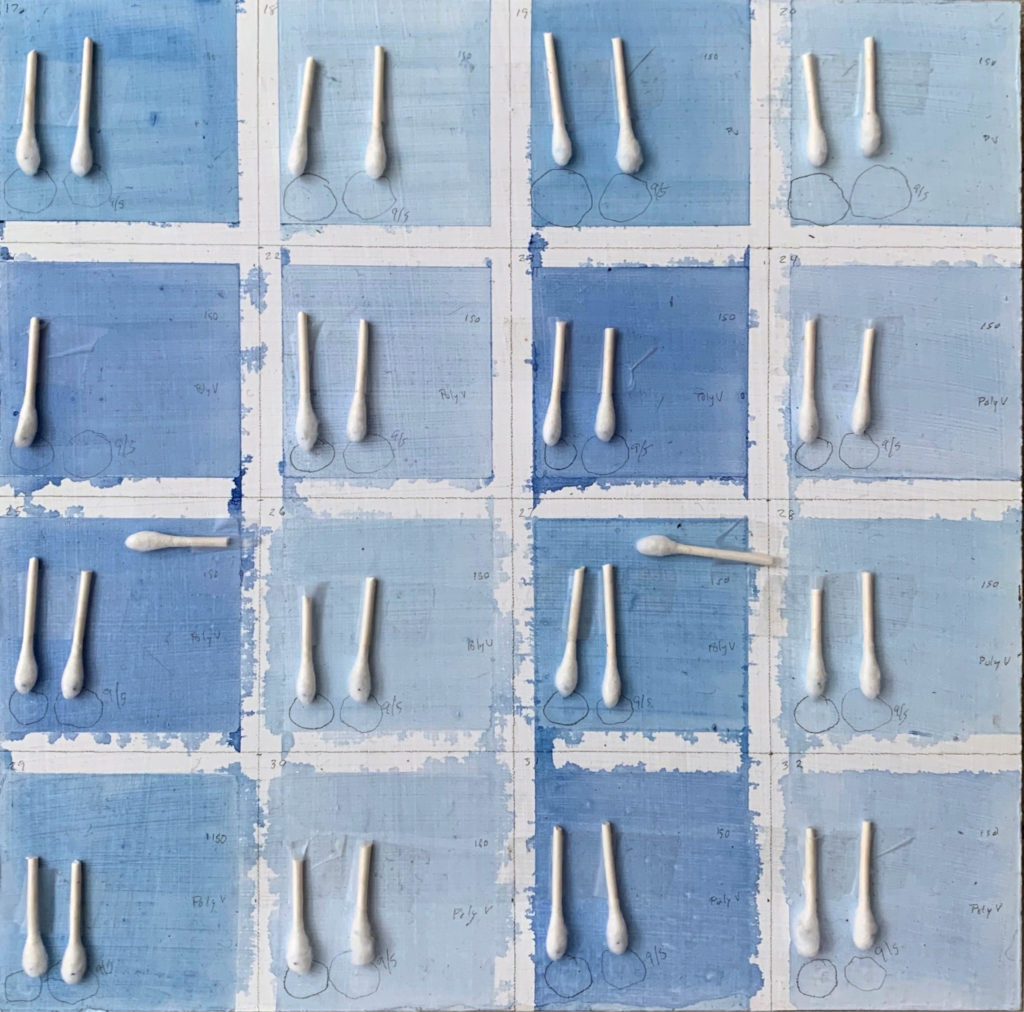
In blog posts and workshops the warnings tin can seem dire: add too much water, we are told, and the acrylic binder will break down, causing paint to flake off or adhesion to fail. Some will ready the magical mark at 30%, others at 50, merely near universally the rules are presented without citing or showing any evidence. So nosotros thought nosotros would fill in some of those blanks and share what our testing reveals.
Water is conspicuously a central ingredient of artists' acrylics, which even at the start volition usually incorporate somewhere betwixt 45-55% water. And then it can experience natural to exist hesitant before adding a lot more. Surely at that place must be a breaking indicate, but where? For years our standard advice was that a one:1 ratio was very safety for most of our paints and mediums; plus, it had the advantage of being like shooting fish in a barrel to recall while greatly erring on the side of caution. Even so, our current testing shows you can go a lot farther than that before encountering significant issues. Just how far?Nosotros think you lot will be surprised.
Core Findings
- Adhesion: We saw no adhesion failure of any of our paints, no matter how thinned downwardly with water, when applied on top of acrylic gesso.
- Sensitivity to water and other acrylic products: Colors we tested that are typical of our line, like Yellow Oxide and Phthalo Blue Green Shade, showed no sensitivity to water or various acrylic products even when thinned with 20 parts water. In fact, sensitivity was by and large express to worst-case scenarios of highly thinned down mixtures (i:xx and 1:100) involving pigments like Raw Umber, which has a high clay content, or the more than dye-similar Anthraquinone Blue.
- A safety mode to thin any ratio of pigment to water: By using a minimum blend of one part acrylic medium to x parts water, we essentially eliminated sensitivity to water or other acrylics, even with highly sensitive pigments thinned at a 1:100 ratio.
The Tests
We tested GOLDEN Heavy Body, Fluid, High Flow and OPEN Acrylics on both forest panels and aluminum plates primed with GOLDEN Gesso. In terms of color, we chose Yellow Oxide (YO) and Phthalo Blue Green Shade (PBGS) as typical of our pigment lines overall, and Raw Umber (RU) and Anthraquinone Blue as beingness outliers that were amid the almost water sensitive. The paints were tested every bit-is and composite with water in book ratios of iii:1, 1:1, 1:three, one:20 and i:100.
The testing was extremely strenuous and went far across what anyone would commonly come across. Adhesion was tested at 24 hrs and 1 calendar week using ASTM'southward Cross Hatch Adhesion Examination (D3359). Water sensitivity was tested at the same intervals, using a cotton swab dampened with water and rubbed x times while pressing downward with very firm pressure, as well equally brushing another area 20 times with water. The only exception was OPEN, which we tested at ane and ii-week intervals instead, due to its ho-hum curing fourth dimension. Additionally, we tested for whatsoever color lift when brushing on Heavy Torso or Open up Titanium White, Polymer Varnish, or our Isolation Coat recipe. Finally, we pre-made 1:5 and 1:10 blends of water with either Fluid Matte Medium or High Flow Medium, and so used those to thin Raw Umber and Anthraquinone Blueish at one:twenty and i:100 ratios. These were and then tested for whatsoever sensitivity at 24 hrs and 1 week. In all, there were some 175 samples generating well more than 1,000 information points.
Some Limitations
While our results should hold truthful on top of other Gilded Paints, Grounds, Gels, and Mediums, because there are so many variables and combinations,it is always important to test for your application. Also, keep in listen that glossy acrylic surfaces might cause some wetting issues when applying highly diluted paints. Nosotros provide some suggestions for dealing with that afterward on. Nosotros did not await at direct adhesion to non-absorbent surfaces like plastic and metal, and then always examination those before utilize too. For suggestions on how to test, please see the Just Pigment commodity Will It Stick? Simple Adhesion Testing In Your Studio. Furthermore, our results would non be applicable to materials similar glass or glazed ceramics that acrylics inherently have poor to moderate adhesion to without the use of special primers, mediums, or preparations. Finally, we did not test other brands of acrylics and cannot speak to how those would perform in like tests.
Results
Adhesion
As mentioned, fifty-fifty thinning the paint with 100 parts water did not lead to any adhesion failure. (Epitome ane) Of course, adding that much water will too turn paint into a stain with no film thickness to speak of. By that signal the pigment is soaking into the absorptive acrylic gesso the same mode watercolor washes will get absorbed by newspaper. However, all the acrylic blends, even the 1:3 or 1:twenty ratios, which still dried with a discernible film, performed well. At least on an acrylic basis, adhesion is simply not a concern.
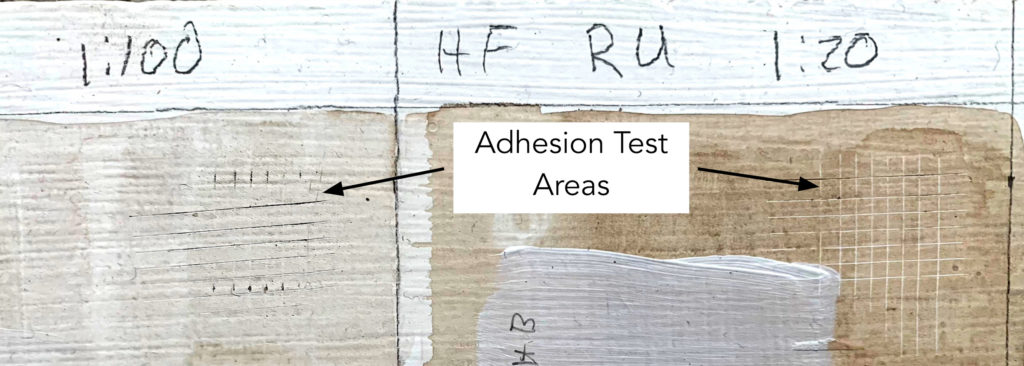
Sensitivity to Water and Other Products
Colors with a Typical Range of Sensitivity: Phthalo Bluish GS and Yellow Oxide
Between these two typical colors from our Heavy Body, Fluid, and High Menstruation lines, just Phthalo Blue GS showed some slight water sensitivity at the 24 hr marking, and that disappeared when it was retested after 1 calendar week. (Image 2)
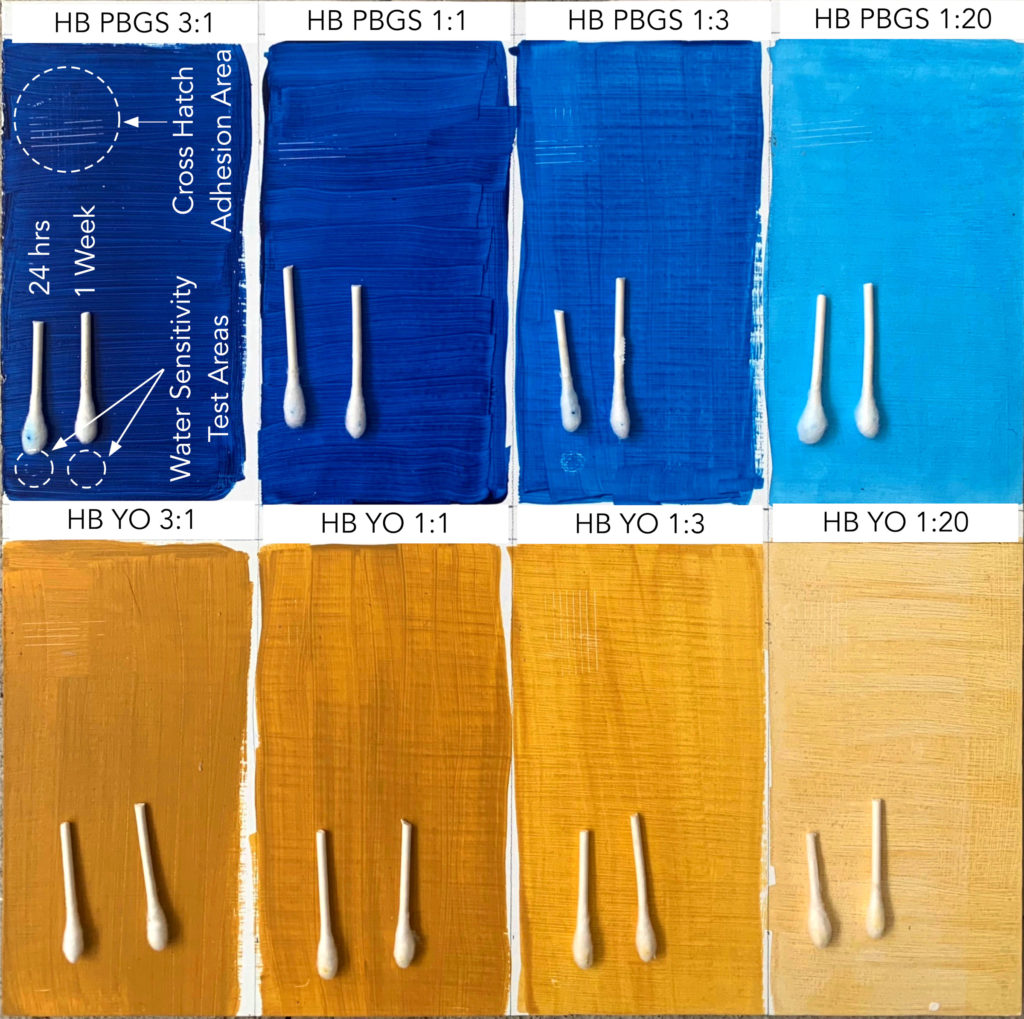
Our OPEN line, past contrast, was tested at 1 and two weeks since it takes longer to lock down. While the cotton swab was able to selection up more color, the color was largely restricted to a concentrated dot, which is more nearly the relatively soft film being physically rubbed off than colour lifting per se. It is likewise important to keep in mind that the cotton wool swab test is a very ambitious one, and this degree of rubbing would rarely be encountered. (Image 3)
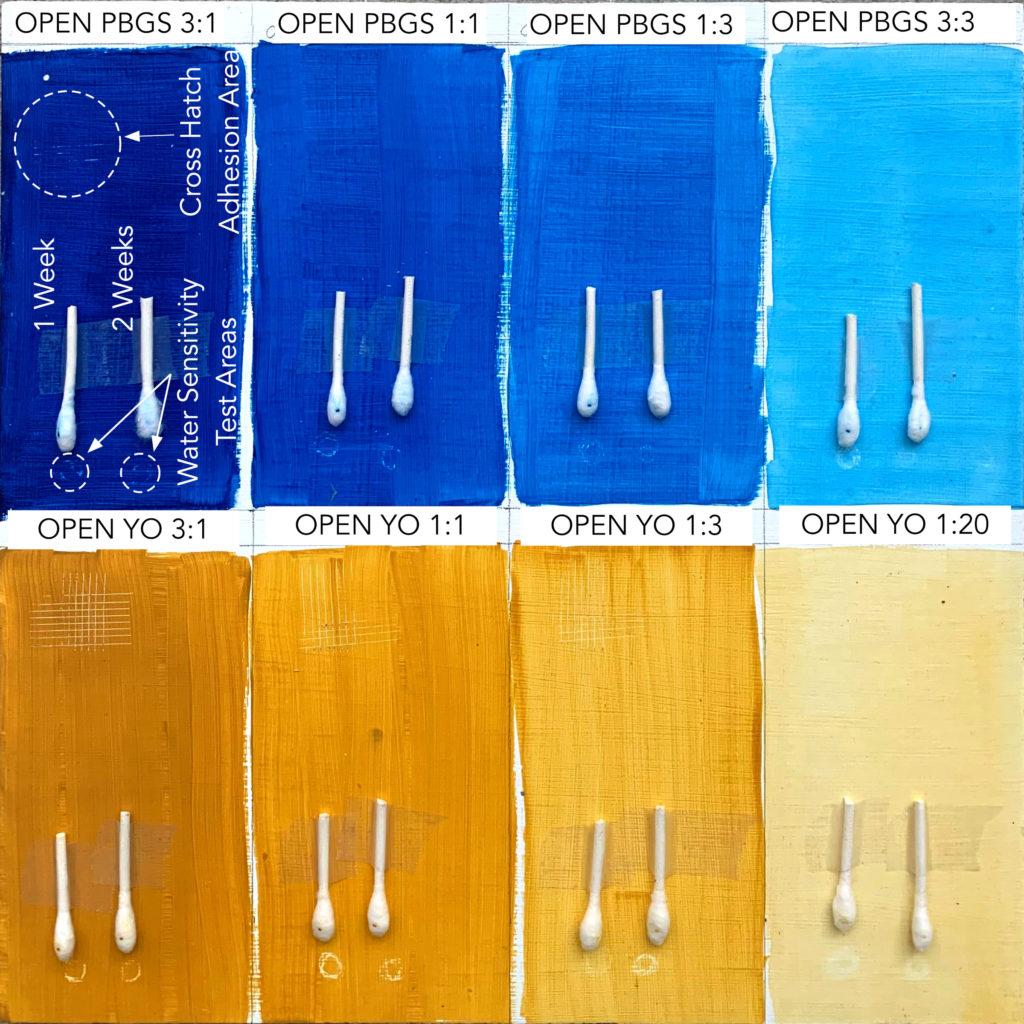
Paints with Higher Sensitivity: Raw Umber and Anthraquinone Blue
Because we had and so few failures with Phthalo Blue and Yellow Oxide, we decided to continue the testing using Anthraquinone Blueish and Raw Umber, a pair of highly sensitive colors representing a 'worst-example scenario'. We left OPEN out of these additional rounds since it presented such unique issues due to its slow drying formula. Instead, we opted for High Flow and Fluid Acrylics, since they are frequently used for wash applications, plus any results from the Fluids would exist applicative to Heavy Torso as well. Finally, nosotros increased the maximum water additions and tested colors at both 1:20 and i:100 ratios; far past what almost anyone would use.
Water Sensitivity
In judging water sensitivity, we wanted to add something less physically aggressive than the cotton wool swab test. We therefore decided to brush h2o xx times over a minor department on the test panels, and so wipe the brush on a clean piece of paper to see if it had picked upwards any balance. And indeed, for the Raw Umber in particular, you could see a very low-cal launder of colour left on the sheet. Only even then, the expanse on the console where we had brushed, appeared untouched. For almost artists under most circumstances, we felt, this corporeality of sensitivity could be acceptable, especially as most people would be doing far fewer passes than we did. And fifty-fifty at the higher level, information technology certainly was non anywhere near the warnings of complete lifting expressed by some. In the cotton swab area, enough color was lifted to all the same exist a concern if someone was rubbing or working the surface more forcefully.
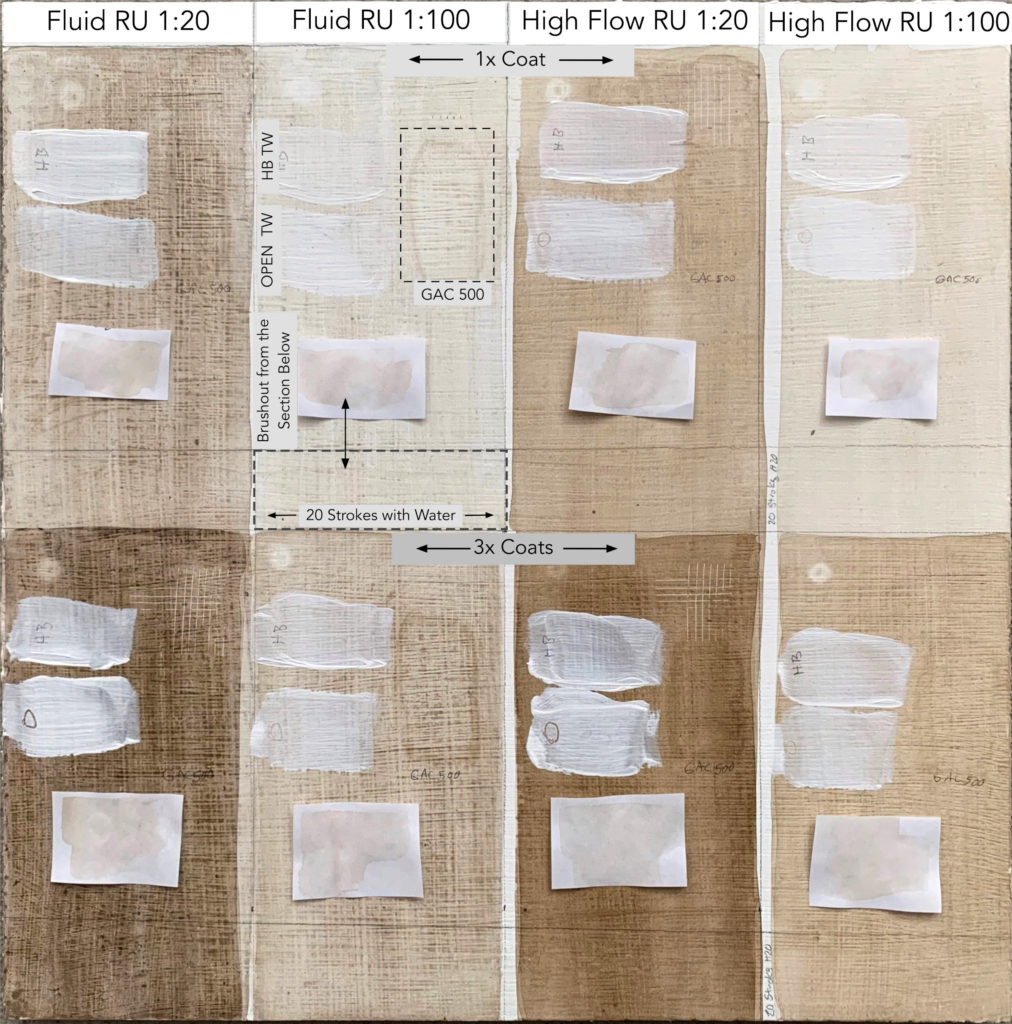
Sensitivity to Other Products
Of grade, only rubbing or brushing water by itself on a surface is just one type of testing, and is not something artists might do frequently outside of cleaning the surface, or using very watered downward washes. So we also tested other types of applications: brushing on a layer of paint (in this instance, Heavy Body and Open Titanium White), adding an isolation glaze of ii parts Soft Gel Gloss and i part water, brushing on GAC 100 and 500, and finally applying our Polymer Varnish. (Image 5)

While the Titanium White brush outs all looked fine, the other products lifted colour to one degree or another, varying by paint line and pigment. While none entailed a significant loss of color, an artist might certainly find information technology while applying an Isolation Glaze or brushing a medium over adjacent colors. Information technology is also worth noting that the Polymer Varnish lifted the most colour, likely due to its unique composition and amine levels. Much more problematic, yet, was the appearance of dark rings around the outer border where many of the articulate mediums and varnish had been applied, in particular, to highly diluted Raw Umber; almost certainly evidence of suspended pigments that were lifted and deposited at that place in the process of drying. (Images four & 5) Yet, even if limited to Raw Umber, it was clearly an issue that needed to exist remedied.
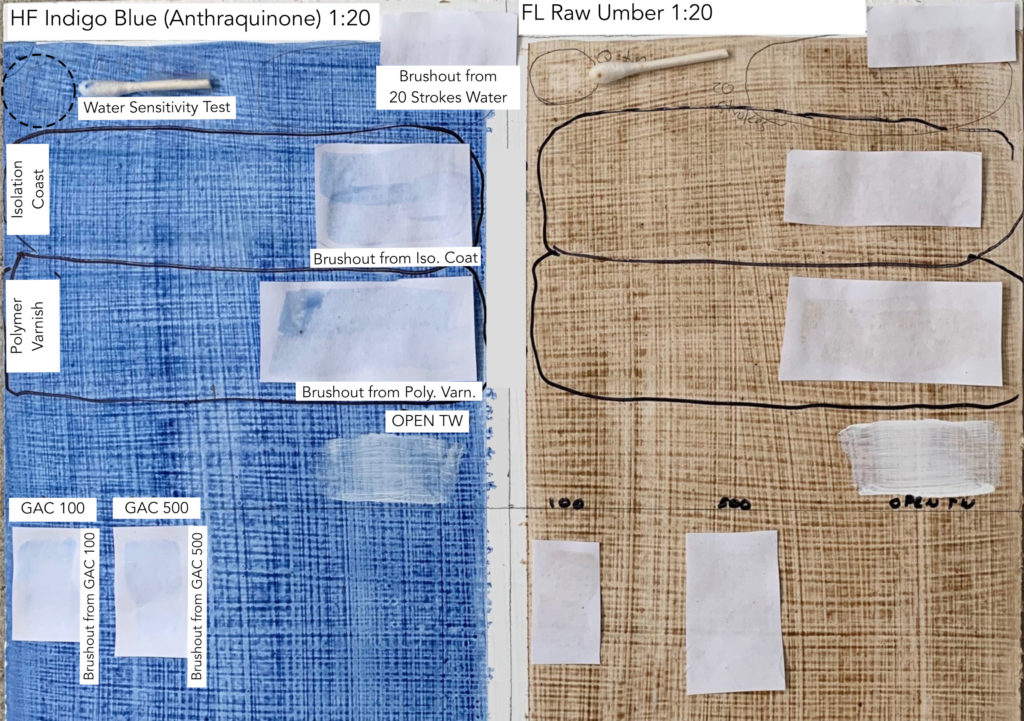
I Like shooting fish in a barrel Fix for the Increase in Sensitivity
Nosotros entered round 3 of our testing hoping that a simple blend of some acrylic medium and water could exist an piece of cake solution to the earlier problems. Nosotros therefore tested mixing Fluid Matte Medium or High Flow Medium at both 1:five and 1:10 ratios with h2o, and then blending each of those at 1:20 and one:100 ratios with paint. These were brushed onto an acrylic gessoed panel where, after merely 24 hrs, nosotros saw almost no evidence of sensitivity outside of a handful of cases, and even those all showed improvement when reexamined a week afterwards. Also, when we tested the cotton swab on top of an expanse with an isolation coat, even if we rubbed 30 times while using a lot of pressure, nosotros could non become any amount of color to elevator. And reassuringly, the cruddy dark rings that we saw earlier were no longer an issue. Lastly, and perhaps simply as importantly, these thinned downward mixtures of water and medium really felt indistinguishable from using h2o solitary.
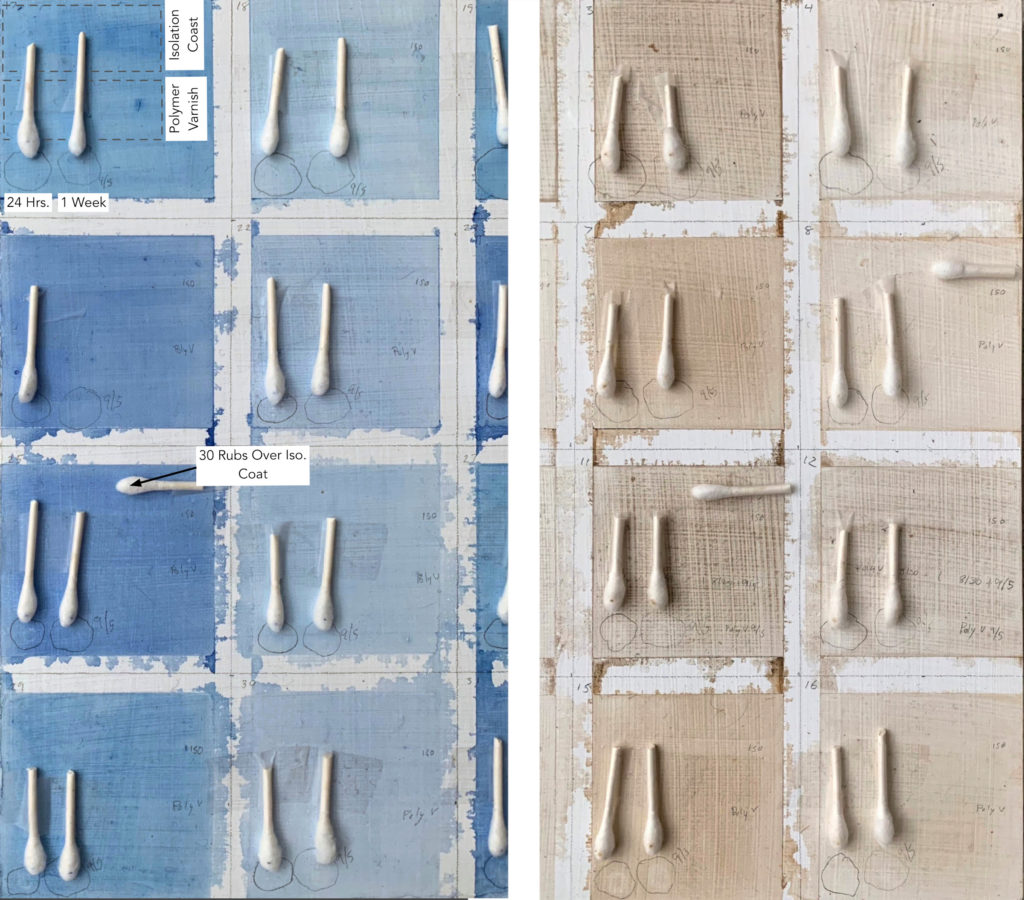
Changes to Other Backdrop
Handling, Sheen, Wetting, and Stability in Storage
When thinning paints with h2o more than just adhesion or sensitivity can be impacted. The entire experience and performance of the paints modify also, and can often be a major reason for wanting to use or add mediums rather than h2o alone.
- Handling: the more h2o that is added, the more the paint will feel….well, watery! Which of form is non a surprise, but certainly something to be aware of. Otherwise the rich transparent glaze you were hoping for might announced more similar a thin watercolor wash afterward information technology dries. And of course, thinned downward paint can cause runs on a vertical surface, puddle on a apartment ane, or cause things similar newspaper to buckle and warp. So ever exercise some testing to make sure that simply adding water gives you what yous want. If it doesn't, and you want something thicker in feel or richer in binder, so try experimenting with dissimilar ratios of water and acrylic medium until you find the residue you are looking for. Or even effort using our Loftier Flow Medium by itself, which is the thinnest of our mediums and can ofttimes deed as an alternative to water while maintaining a loftier binder level and imparting a glossy advent.
- Sheen: The more water you add, the more matte the paint volition go, regardless of what sheen or line of paint you start with. Chart ane shows the modify in gloss for two of the colors as they were increasingly thinned down. This tin can also impact the appearance since matte colors appear lighter and less saturated. If this is a concern, adding mediums can help give y'all more control in this area. Notwithstanding, at the ratios that we blended mediums and water in our tests (1:5 and 1:x), the results withal appeared adequately matte, so you would need to continue adjusting the ratio to become the sheen yous want. Or again, look to using High Flow Medium by itself for a sleeky film.

- Wetting:The acrylic lines are formulated with an optimal level of surfactants that, amongst other things, will aid them wet-out a multifariousness of surfaces more easily. Equally more water is added, these surfactants get diluted and y'all might find that the pigment begins to bead upward or crawl on some surfaces, like metal or some plastics, or resists penetrating into raw sail. To solve this you could endeavour mixing more medium with the water, or add a tiny amount of our Wetting Agent into the h2o you lot plan to use, making sure to follow the directions very advisedly as this is a highly concentrated material and adding also much will cause other issues.
- Storage:The more watered down the pigment, the more than the pigment particles volition start to divide out and gravitate towards the bottom. To prevent this while working, you will need to stir periodically to keep them in intermission. It is besides best to only mix up as much as you need in the very short term as very thinned out paints tin develop mold since the overall pH starts to move towards neutral and the biocides that were originally added accept become too diluted to be constructive. If you lot need to brand upwards larger quantities, ever utilise distilled water and store in clean uncontaminated containers. Also, adding a very small amount of unscented household ammonia (about a capful per gallon of water) will maintain an alkaline metal pH that discourages spoilage.
Our Recommendations
Given all of the results, where do we end up in terms of recommendations? While at that place is nothing incorrect with our older advice of a ane:1 ratio, which is both easy to remember and eyeball in mixtures, it remains an extremely conservative limit and we want people to feel more confident and comfortable exploring mixtures well higher up that. Nosotros hope the guidelines below will assist:
Get-go, simply a reminder that the following guidelines are for using GOLDEN Heavy Body, Fluids, and High Menses Acrylics on top of Gold Gesso, Mediums, or Grounds, besides equally other layers of those same paint lines. We can not speak to the performance of other brands of acrylics.
And, even more chiefly: E'er Test for your application to make sure information technology meets your needs and expectations.
Adhesion
- In all our testing adhesion was never an issue, even at 1 part pigment to 100 parts water.
Up to 1:20 Paint to Water
Water Sensitivity
- While for most colors this should remain a non-issue, even at higher levels of dilution, we did see an increase in water sensitivity for things like Raw Umber, with its naturally loftier clay content, or the more dye-like Anthraquinone Blue. Other examples will most likely vary with paint lines and the nature of your application. If you merely desire to have the guesswork out of information technology, you can e'er blend a minimum of 1 role GOLDEN Acrylic Medium, like our Fluid Matte Medium, Gloss Medium, GAC 100, or High Menstruation Medium, and x parts h2o. And so thin to your middle's content. And if ever in doubt, water sensitivity is super easy to test with a cotton swab or piece of cotton fiber textile and some water. Just let the application dry completely and know that water sensitivity will often improve with time.
Sensitivity to Other Products
- While we only tested Heavy Body and OPEN Titanium Whites, we do non anticipate any problems applying additional layers of Gilt Acrylic Colors.
- Applying Polymer Varnish or GOLDEN Mediums, including our brush-on Isolation Coat recipe of Soft Gel Gloss and water, directly to highly thinned and h2o sensitive colors, tin can cause some colour lift. And for some colors, like Raw Umber, dark halos might develop around the outer edges of the application. If needed, a sprayed on Isolation Glaze might be required, or utilise of our Archival Varnish as a style to decrease sensitivity before applying further layers. Alternatively, follow instructions beneath to increment film durability.
In a higher place a 1:20 ratio of paint to water, or whenever needing decreased h2o sensitivity
- Nosotros recommend using a minimum of ane function GOLDEN Medium to x parts water to sparse acrylics to a higher place a ane:20 ratio, or whenever more durability is needed. Doing so will increase film strength and lower sensitivity to both h2o and other Aureate Mediums and Varnishes.
Note on Open up Acrylics and Mediums
With OPEN Acrylics, adding large amounts of water gets a little more than complicated equally it will greatly reduce the working fourth dimension of the paint, which is usually the master reason people use it in the first place. And of grade, every bit we shared, water sensitivity is generally higher in this line. That said, just in terms of adhesion, we saw no problems in our tests which went as high as a 1:twenty ratio of OPEN to water. If wanting to hold onto more of the working fourth dimension of the OPEN, and still create a launder, explore using either our Open Thinner or a blend of water and OPEN Medium.
Some thinned down GOLDEN Acrylic Colors showed increased sensitivity to Open up Thinner, which has a loftier level of glycols. This sensitivity might extend to other OPEN Products, and so always test if using on elevation of highly thinned down washes. Use of an Isolation Glaze, when possible, would be recommended, or thin the initial layers of acrylics using our recommended minimum alloy of 1 office medium to x parts water
How Much Water Can You Add To Paint,
Source: https://justpaint.org/how-much-water-can-you-safely-add-to-acrylic-paint/
Posted by: bowyerhunhis.blogspot.com



0 Response to "How Much Water Can You Add To Paint"
Post a Comment